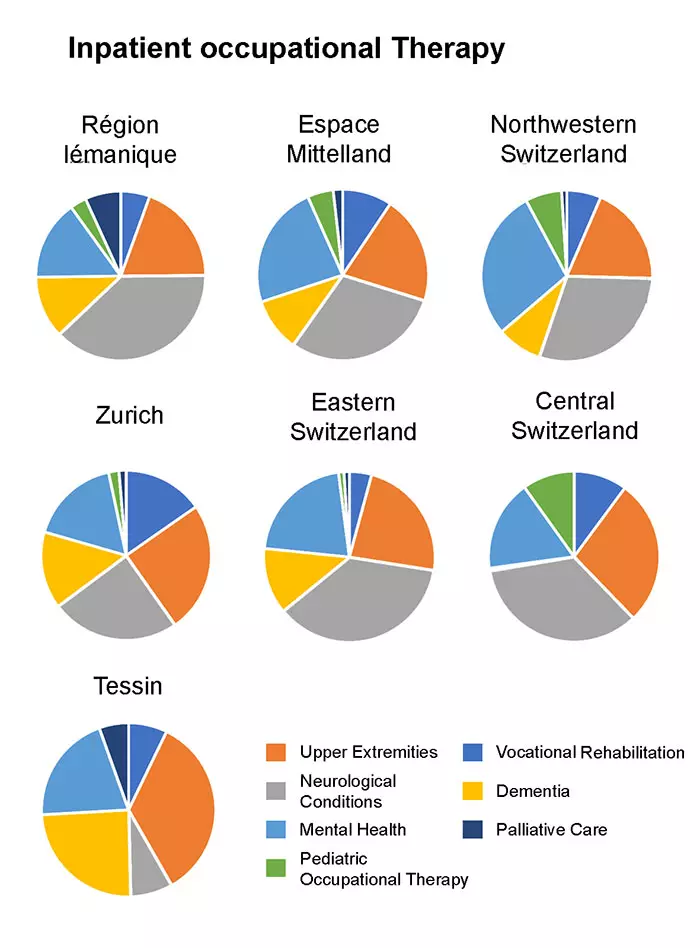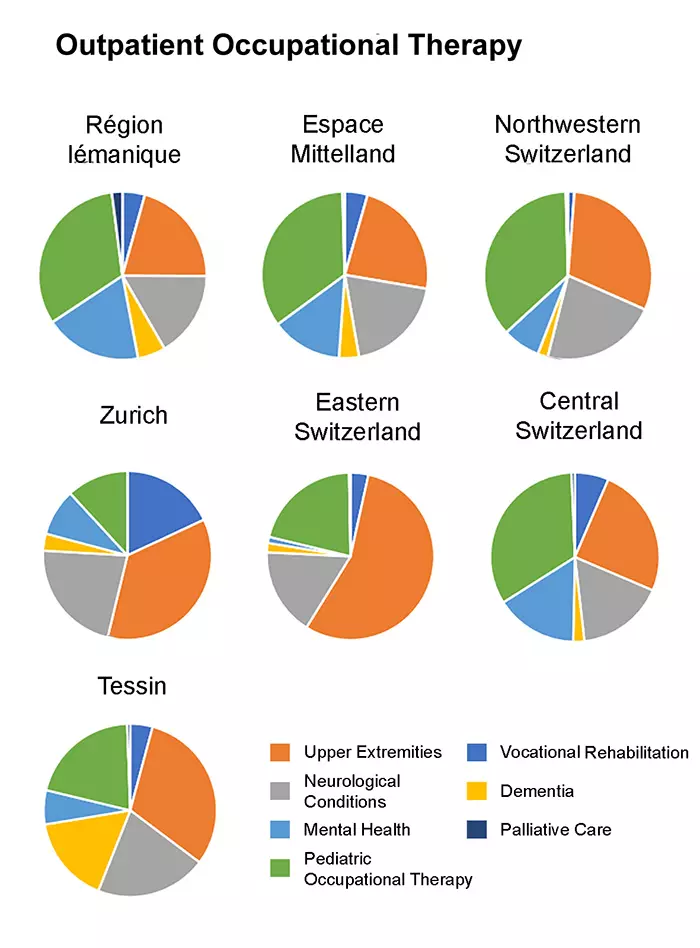The Size and Structure of the Swiss Occupational Therapy Workforce
In this project, comprehensive data on occupational therapists working in Switzerland was collected for the first time. The results show, for example, the number of professionals per region, field of practice, and setting, as well as the types of employment, number of job vacancies, and information on funding bodies.
Background
The shortage of skilled labour in the healthcare professions is also being felt in occupational therapy. The availability of reliable data on the number and structure of occupational therapy jobs is important to determine the need for occupational therapists in the various regions and fields of practice in Switzerland, to plan study places, and to make political decisions. Such data can both identify gaps in provision and support the planning of measures to ensure that institutions can find the occupational therapists with the required skills they need.
Aim
The aim of the study was to collect empirical data on the number and structure of occupational therapy workplaces in Switzerland.
Method
We conducted a Switzerland-wide online survey aimed at employers of occupational therapists, managers of occupational therapy teams, and self-employed occupational therapists. The researchers collected data on the number and structure of occupational therapy workplaces in Switzerland, regarding socio-demographic characteristics, therapists' level of training, regional distribution of workplaces, areas of work, and other topics. Quantitative data was analysed using descriptive statistics and regression analysis. In addition, the researchers described qualitative data, derived from open questions, narratively.
Results
In total, data was collected from 968 respondents regarding 3’022 Swiss occupational therapists. In the following, you can find the most important results. The complete data is available as Open Research Data.
Swiss occupational therapy provision in the European context
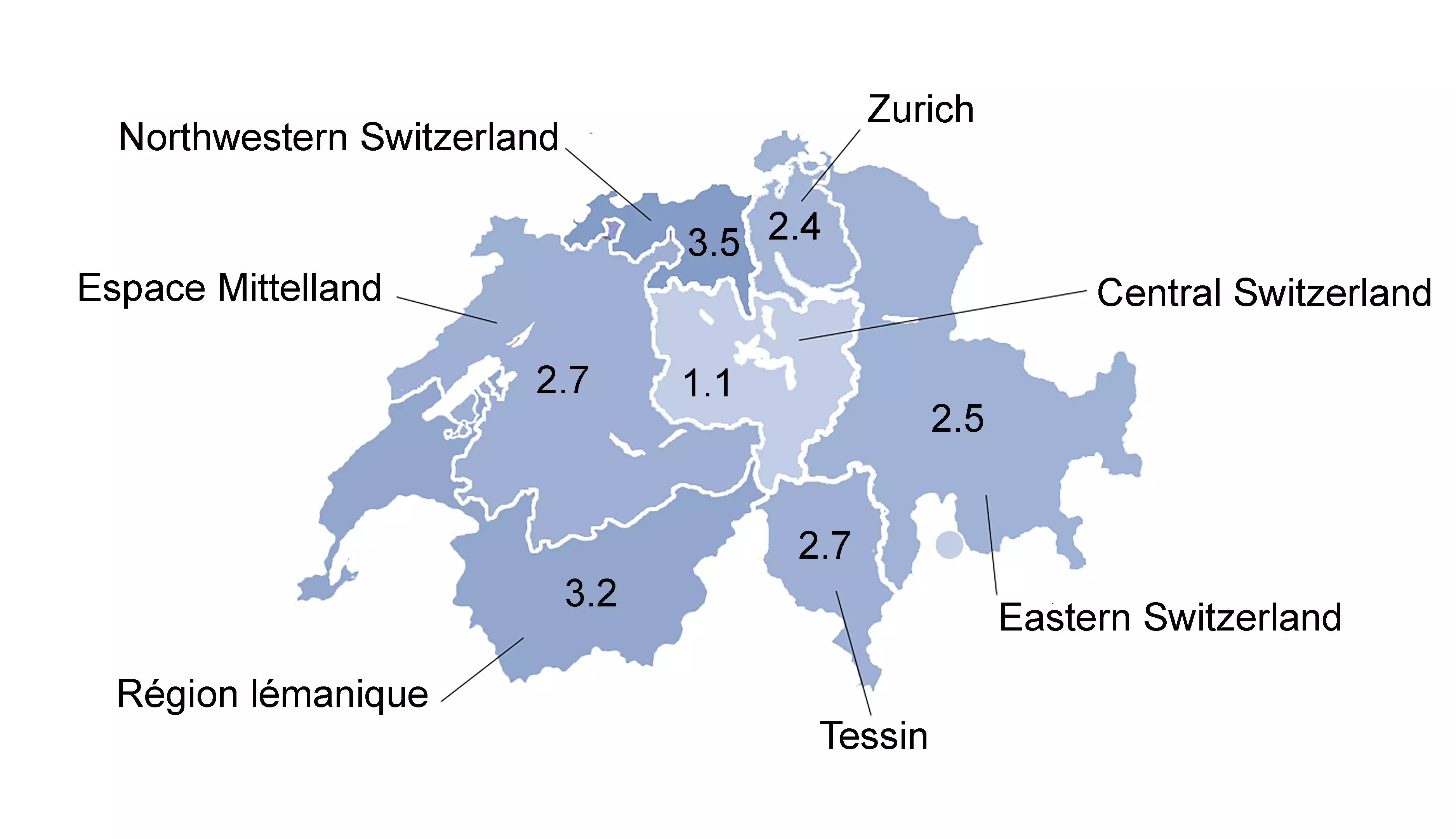
The number of occupational therapists per 10’000 inhabitants in Switzerland is at least 3.2, with an estimated real ratio of 4.2 - 4.6. Provision is somewhat denser in western Switzerland and least dense in central Switzerland. This puts Switzerland in a better position in terms of occupational therapy provision than Italy (0.4 per 10’000) or France (2.2 per 10’000), but well behind Germany with 7.3 occupational therapists per 10’000 inhabitants.
Proportion of women is higher than in neighbouring countries
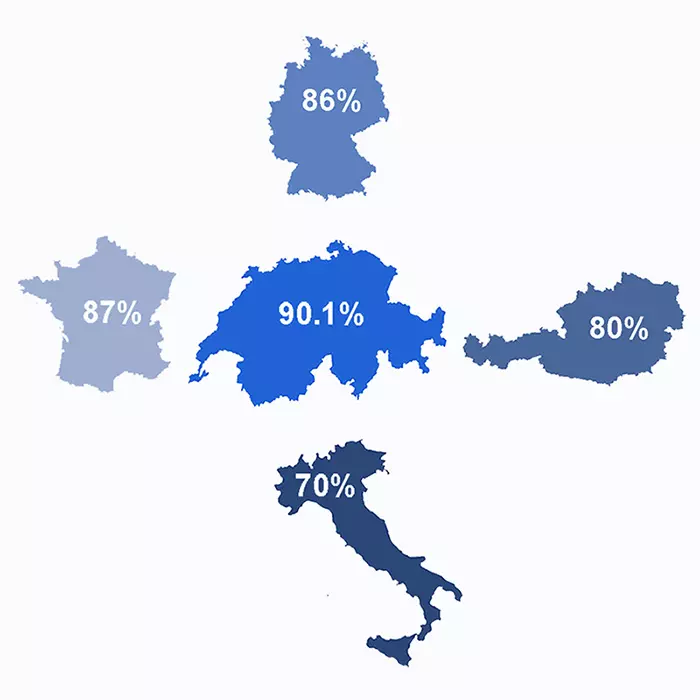
Men make up only 9.7% of occupational therapists in Switzerland, while women make up 90.1%, and 0.2% do not identify with either gender. The proportion of men in management positions is somewhat higher (15.5%). Although the proportion of male occupational therapists in Switzerland is close to the global average, it is lower than in neighbouring countries, in some cases significantly. The proportion of men among Swiss occupational therapists is also significantly lower than among Swiss physiotherapists (24%) and Swiss nurses (14%). It is unclear why the gender diversity in occupational therapy in Switzerland is so low, even in comparison with other countries and other healthcare professions. However, it is clear that there could be potential for the profession here - also with regard to the shortage of skilled labour.
Fewer master’s and doctoral degrees than in other healthcare professions
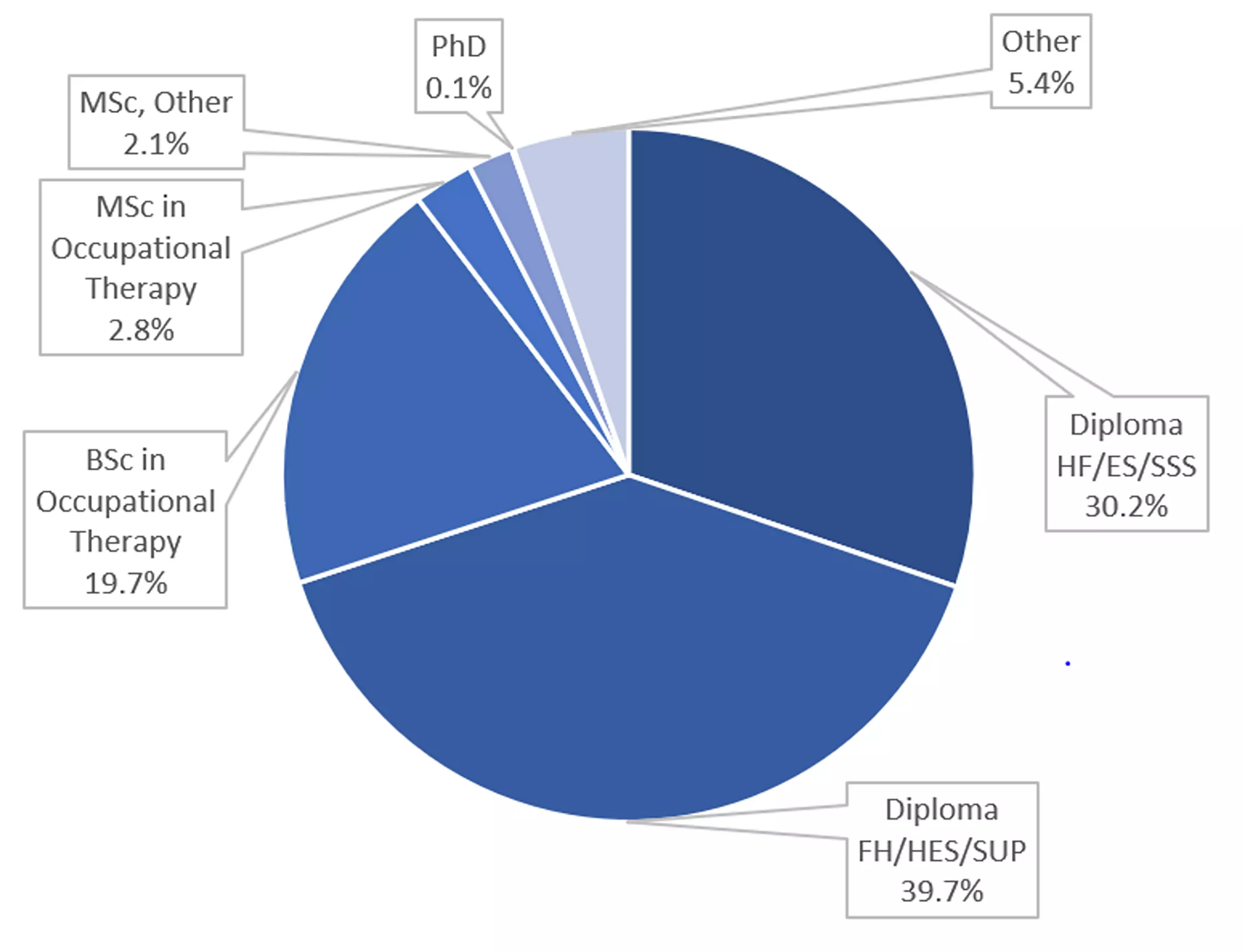
Almost 60% of Swiss occupational therapists have an FH/ES or bachelor’s degree, although this proportion is higher among younger professionals. However, only 4.9% have a master’s degree, just over half of them in occupational therapy. While the proportion of occupational therapists with a bachelor’s degree or higher in Switzerland is similar to that of physiotherapists, the proportion of physiotherapists with a master’s degree is more than twice as high as that of occupational therapists. So here, too, there is still real potential for development.
Differences in care according to specialist areas
The density of occupational therapy providers differs not only by region, but also by field of practice. For example, outpatient occupational therapy for people with dementia appears to be comparatively more established in Ticino than in other regions of Switzerland. In palliative care in the inpatient sector, occupational therapy appears to be more firmly established in Ticino and western Switzerland than in other parts of Switzerland, while outpatient psychiatric occupational therapy appears to be less well represented in eastern Switzerland.
Two thirds of services covered by compulsory health insurance

In Switzerland, occupational therapy is most frequently funded through compulsory health insurance. Two thirds of services are reimbursed in this manner. Other important funding bodies are disability insurance (16%) and accident insurance (14%). Only a comparatively small part is covered by supplementary (private) insurance, self-payers and military insurance.
Reports and data
The data and questionnaires for this study are available as Open Research Data (ORD) on SWISSUbase:
Gantschnig, B. E., Ballmer, T., Petrig, A., Eggenberger, B., Moioli, S., & Kühne, N. (2024). Survey on the Size and Structure of the Swiss Occupational Therapy Workforce (Version 1.0.0) [Data set]. FORS data service. https://doi.org/10.48573/19ba-jz05
ZHAW Publikationsdatenbank
-
Gantschnig, Brigitte Elisabeth; Ballmer, Thomas Michael; Petrig, Andrea Marlis; Kühne, Nicolas; Eggenberger, Brigitte; Moioli, Stefania,
2024.
In:
6. Kongress der Ergotherapie, Fribourg, Schweiz, 24.-25. Mai 2024.
-
Hubschmid, Andrea Verena; Gantschnig, Brigitte Elisabeth; Ballmer, Thomas Michael; Andersen, Mette,
2024.
Rekrutierung von Ergotherapeut*innen in der Schweiz.
Ergotherapie.
2024(4), pp. 28-31.
-
Kühne, Nicolas; Ballmer, Thomas Michael; Eggenberger, Brigitte; Moioli, Stefania; Petrig, Andrea Marlis; Gantschnig, Brigitte,
2024.
Formation des ergothérapeutes en Suisse.
Ergotherapie.
2024(2), pp. 9-13.
-
Gantschnig, Brigitte Elisabeth; Ballmer, Thomas Michael; Moioli, Stefania; Petrig, Andrea; Eggenberger, Brigitte; Kühne, Nicolas,
2023.
Charakteristiken von Ergotherapeut*innen in der Schweiz.
Ergotherapie.
2023(12), pp. 14-17.
-
Petrig, Andrea Marlis; Ballmer, Thomas Michael; Kühne, Nicolas; Eggenberger, Brigitte; Gantschnig, Brigitte,
2023.
Angaben zu den Arbeitsverhältnissen der Ergotherapeut*innen in der Schweiz.
Ergotherapie.
2023(10).
-
Ballmer, Thomas; Kühne, Nicolas; Petrig, Andrea; Eggenberger, Brigitte; Gantschnig, Brigitte,
2023.
Verteilung der Ergotherapeut*innen in der Schweiz.
Ergotherapie.
2023(8), pp. 22-25.
-
Eggenberger, Brigitte; Ballmer, Thomas Michael; Kühne, Nicolas; Moioli, Stefania; Petrig, Andrea; Gantschnig, Brigitte,
2023.
Berufsrelevante Erkenntnisse zur Förderung der Ergotherapie.
Ergotherapie.
2023(6), pp. 28-31.
-
Ballmer, Thomas; Kühne, Nicolas; Petrig, Andrea Marlis; Eggenberger, Brigitte; Moioli, Stefania; Gantschnig, Brigitte E.,
2023.
The size and structure of the Swiss occupational therapy workforce : a survey study.
International Journal of Health Professions.
10(1), pp. 57-67.
Available from: https://doi.org/10.2478/ijhp-2023-0007
-
Moioli, Stefania; Kühne, Nicolas; Egger, Selina Marita; Gantschnig, Brigitte; Ballmer, Thomas Michael; Eggenberger, Brigitte; Petrig, Andrea,
2021.
Wer sind wir und wenn ja, wie viele?.
Ergotherapie.
2021(8), pp. 16-19.
Projekt Organisation
Project lead
Prof. Dr. Brigitte Gantschnig
Project period
November 2018 - Januar 2024
Project team
Thomas Ballmer, Andre Bürki (†), Brigitte Eggenberger, Selina Egger, Prof. Dr. Nicolas Kühne, Stefania Moioli, Andrea Petrig, Prof. Dr. Christina Schulze, Ines Wenger
Project partners
- Haute école spécialisée de Suisse occidentale
- Scuola universitaria professionale della Svizzera italiana
- ErgotherapeutInnen-Verband Schweiz (EVS)
- Stiftung für Ergotherapie
Funding
Project status
On going
